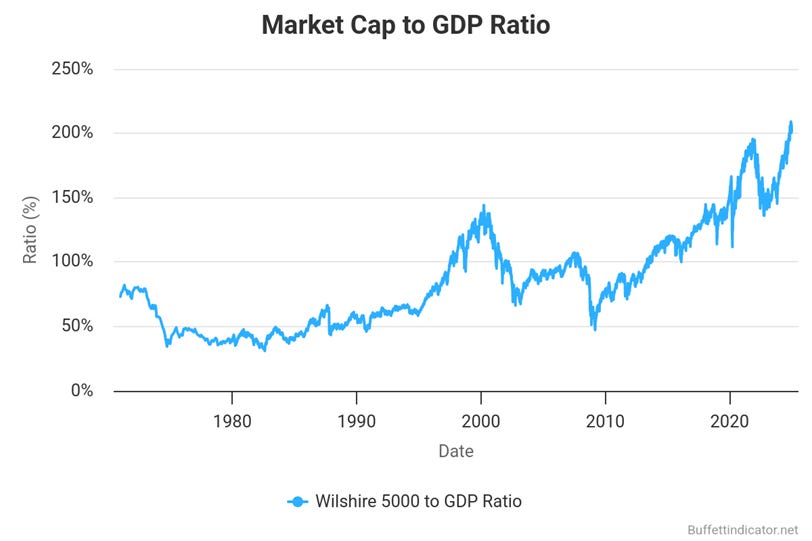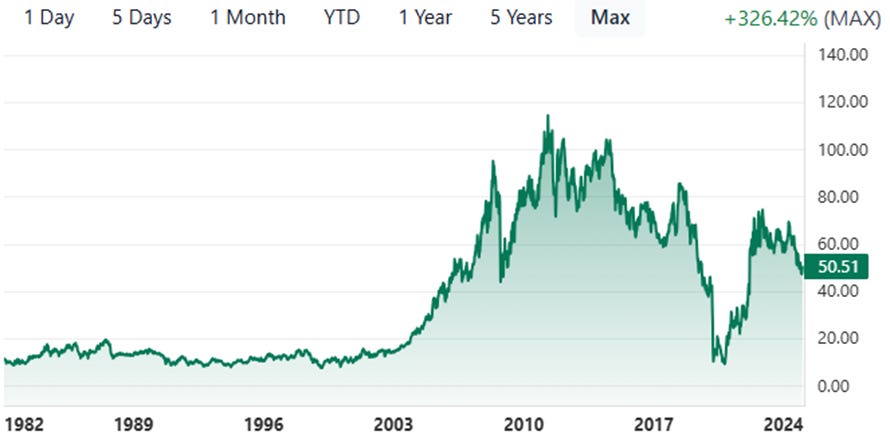Warren Buffett needs no introduction. He is a legend among legendary investors. A share of his company (BRK.A) traded for $255 in 1980 and is now worth $681,460. By comparison, a $255 investment in the S&P Index in 1980 would be worth $42,085 today (calculator link: https://www.officialdata.org/us/stocks/s-p-500/1980?amount=255&endYear=2024). Quite a difference.
Much has been made in the media of Warren Buffett's recent acquisition of 8.9 million shares of Occidental (OXY) in December 2024 - as if this was a major acquisition for Warren Buffet. It wasn't. It only increased his stake in Occidental (OXY) by 3.5%. This acquisition is interesting for other reasons. More on that below.
Warren Buffett has also massively increased his cash holdings from $167 billion in December 2023 to $325 billion in September 2024 (according to his latest SEC 10-Q report). Much of this was financed by selling a large portion of his massive Apple holdings. More on that and the potential reasons below.
Warren Buffett Sells Apple
When you talk about Warren Buffett's portfolio, it is massive and more like a supertanker than a speedboat.
If you know anything about boating, you know that the bigger the boat, the longer it takes to correct course. A small speedboat can go from zero to full speed and back to zero in a short period of time. A supertanker takes much longer. It takes about 20 minutes for a supertanker to come to a complete stop at normal speed. Turning is similar. A small speedboat can turn on a dime. The turning diameter of a supertanker is about 1.2 miles. (Source: https://www.wikimotors.org/how-long-does-it-take-a-supertanker-to-stop.htm).
I explain the 101 of boating because to understand Buffett, you need to look at his investments over several quarters to better understand what he is doing. He is a supertanker legendary investor.
His portfolio is so massive that if he decided to get out of Apple, for example, he couldn't do it overnight because the market isn't liquid enough. It will take several months to unload a large position without crashing the market price. This is a common challenge for large investors. Small investors can hop and skip out of the market without moving it. Massive investors like Buffett can't.
Back to Apple. In December 2023, Warren Buffett's company, Berkshire Hathaway, owned an astonishing 905,560,000 shares with a total value of about $174 billion. This was Buffett's largest portfolio position at the time, accounting for nearly 50% of his invested portfolio in December 2023. According to his latest SEC filing in November 2024 for the period ending September 30, 2024, he has reduced his holdings by 2/3. He now owns only 300,000,000 shares with a total value of about $70 billion, accounting for about 26% of his invested portfolio as of September 30, 2024. As one can see in the chart below, it took Buffett nine months to reduce his huge Apple position.
Number of Apple (AAPL) shares owned by Berkshire Hathaway
The question is why Buffett is selling Apple so massively. In August 2024, Warren Buffett spoke about it a bit cryptically. He said,
"So we will end up, unless something dramatic happens that really changes our capital allocation strategy, we will have Apple as our largest investment. But I don't mind building the cash position in the current environment."
So, in other words – he prefers cash over Apple in the current environment, and that is why he sold so much. And even though he sold a lot of Apple shares, Apple will most likely continue to be his number one investment by market value.
You can see Warren Buffett's answer for yourself by fast-forwarding to timestamp 4:16.
He used most of the proceeds from the Apple sale to fund his rapidly growing cash position. More on that next.
Warren Buffett Goes Cash
Warren Buffett has increased his cash position (cash & US treasuries) from $167 billion in December 2023 to $325 billion in September 2024 (the last reported quarter). That is a massive increase.
Berkshire Hathaway – Cash Position in $ Billion
The change is even more impressive when one looks at the total context - the cash position plus the total investments.
As his cash balance increased, his invested portfolio was reduced – from about $353 billion in December 2023 to about $271 billion in September 2024; in other words, his cash position is now larger than his invested portfolio.
In December 2023, 68% of his portfolio was invested and 32% was in cash.
In September 2024, 46% of his portfolio was invested and 54% was in cash.
Berkshire Hathaway – Invested Portfolio vs. Cash Position – December 2023 vs. September 2024
The question is why?
I believe there are 3 answers:
First, his statement in the above YouTube video, "But I don't mind at all building the cash position under current conditions." He didn't elaborate on what he meant by "current conditions." But the increased allocation to cash speaks volumes. It means he doesn't see compelling investment opportunities right now and is waiting for better investment days.
Second, his famous quote: "Be fearful when others are greedy, and be greedy when others are fearful." And the US stock market is currently still very bullish in outlook. It means, based on Buffett’s actions, that Buffett sees the market as greedy, so he is fearful and moving more and more to cash.
Third, the famous Buffett indicator, explained in more detail below, shows a US stock market that is significantly overvalued..
So what is the Buffett indicator?
The Buffett Indicator
The Buffett indicator was proposed as a metric by legendary investor Warren Buffett in 2001, who called it
"probably the best single measure of where valuations stand at any given moment"
(https://en.wikipedia.org/wiki/Buffett_indicator). The Buffett indicator provides insight into whether a stock market is overvalued or undervalued:
A ratio around 100% is considered normal
Values well above 100% may indicate overvaluation
Values below 100% may indicate undervaluation
The Buffett indicator is calculated by dividing the total market capitalization (share price times number of shares outstanding) of all publicly traded stocks in a country by its gross domestic product (GDP).
As with all indicators, this one shouldn't be taken as gospel, but rather as directional insight. It is like driving your car and noticing that the engine temperature gauge is higher than usual. This could be a sign of something serious, or just the result of a hot summer day.
But definitely something to pay serious attention to. Currently this ratio is about 200%. So, at first glance, this would seem to indicate a significant overvaluation of the US stock market.
Source: https://buffettindicator.net/
The next level of analysis would be to peel back the onion a bit more and see if the overvaluation is across most companies or driven by a few highly overvalued companies. But that is a topic for a future article. For now, given Buffett's published thinking and based on his YouTube video interview above, he sees value in increasing cash reserves - meaning he expects to be able to buy stocks at a much lower price at some point. Of course, that doesn't stop him from buying opportunistically when he sees stocks he likes. One such recent acquisition is the purchase of 8.9 million shares of Occidental (OXY), which is discussed in the next paragraph.
Buffett Adds Oil
Investing in oil has become a political issue. Some ignore it for environmental reasons, believing that the future is green energy. And they may be right. Others feel an oversupply of oil/gas is coming. Still others, like Warren Buffett, have invested a substantial and growing portion (about 11% for Buffett as of September 2024) of their portfolios in oil and gas companies, believing that the combination of limited oil supply, continued reliance on oil, and continued inflation will drive up oil prices, and thus oil company stock prices.
Buffett currently owns oil companies Chevron (CVX - 5th largest position) and Occidental (OXY - 6th largest position) and added 8.9 million shares of OXY in December 2024, increasing his existing OXY position by 3.5%.
Institutional asset managers like Warren Buffett are required to file a quarterly disclosure with the SEC called SEC Form 13F-HR, which is required to be filed with 45 days after the end of each calendar quarter. So the last quarterly disclosure for Buffett’s company Berkshire Hathaway was filed November 11, 2024 for the quarter ending September 30, 2024. The next quarterly disclosure, for the quarter ending December 30, 2024, will be filed sometime around the middle of February 2025.
Additionally, if an institutional investor owns more than 10% of a company, he is considered a company insider, which requires him to file SEC Form 4 within 2 business days of the transaction. The December 2024 data in this article is based on the latest 13F-HR for September 30, 2024, adjusted by the most recent SEC Form 4 filings. For Occidental, Buffett is considered an insider.
Since December 2023, Buffett has slightly reduced his position in Chevron (CVX) in Q1 and Q2 of 2024 (highlighted in orange below) and increased his position in Occidental (OXY) in Q1 and Q2 of 2024 and most recently in December 2024 (highlighted in green below). Warren Buffett now owns about 28% of Occidental's outstanding shares. That will give him a lot of influence in the management of OXY.
The overall allocation to the oil sector, based on market value, increased slightly from 9.4% in December 2023 to about 11.3% in September 2024.
Opportunity
During Warren Buffett's recent purchase of OXY, the average price was around $48 and the low was around $45. Currently, OXY is trading around $50, meaning that an investor who wanted to mirror Warren Buffett's recent purchase of OXY could do so at fairly similar prices.
Occidental Petroleum Corporation (OXY) – 1982 to Jan 2025
NYSE: OXY · US dollar
Source: https://stockanalysis.com/stocks/oxy/
Buffett’s Total Portfolio
As of his most recent SEC filing in November 2024 for the period ending in September 30, 2024, Warren Buffett's company, Berkshire Hathaway, owns shares in 43 companies. However, his portfolio is highly concentrated. The top 10 companies account for about 90% of his total invested portfolio. The top 10 companies have remained the same since December 2023, although the rankings within the top 10 have changed. The current ranking from 1 to 10 is based on the latest known portfolio composition, ranked by market value as of December 2024. Figures highlighted in orange indicate decreases, and those in green indicate increases.
Reductions
Apple (AAPL) - As mentioned above, Buffett has significantly reduced his Apple holdings over the last 12 months from 905,560,000 shares to 300,000,000 shares.
Bank of America (BAC) - Warren Buffett has also reduced his Bank of America holdings by about 25% since June 2024. This is most likely to rebalance his portfolio, generate some cash, and reduce his exposure to the troubled US banking sector. The US banking sector continues to have elevated risks due to unrealized losses on investment securities - a topic for another day.
Chevron (CVX) - Warren Buffett trimmed his investments in Q1 and Q2 of 2024 - at the same time he increased his holdings in Occidental, another oil company, in Q1 and Q2 of 2024, and again in December 2024.
Recent Additions
Occidental Petroleum (OXY) - As mentioned above, Warren Buffett increased his stake in OXY by 3.5% in December 2024, after increasing it in Q1 and Q2 of 2024. He is now a major shareholder (28%) of OXY.
Chubb (CB) - Warren Buffett increased his exposure to insurance company Chubb in Q1 and Q2 of 2024 by about 35%.
Summary
Warren Buffett's reputation as an exceptional investor is well established. His recent actions suggest he may be anticipating economic challenges ahead. This is evidenced by his substantial cash accumulation, reduced holdings in Apple, a premium discretionary consumer goods company (which consumers often cut back on during tough times), and decreased stake in Bank of America (banks tend to face increased losses during economic downturns).
Simultaneously, Buffett appears optimistic about the oil sector, particularly favoring Occidental and Chevron over the traditionally popular Exxon in US oil investment portfolios.
Key Investment Insights Based on Buffett's Actions:
Consider reducing exposure to recession-sensitive investments, such as consumer discretionary spending companies (e.g., Apple) or banks (e.g., Bank of America)
Think about increasing the cash portion of your portfolio to capitalize on potential investment opportunities during future market pullbacks
Explore increasing exposure to the US oil sector, with a focus on companies like Chevron and Occidental
Thank you for reading the article. Hope you enjoyed it.
Hungry for more? Subscribe to the newsletter - it's free and fabulous.Enjoyed this article? Don't keep it to yourself! Share it with a friend or two. It's free, and they might even buy you a coffee as a thank you.Your Fringe Finance
Disclaimer
Neither the author nor Fringe Finance is a financial advisor or a tax professional. This article is for illustrative and educational purposes only and does not constitute a specific offer of any product or service.
Past performance of stocks and assets is not an indicator or guarantee of future performance of stocks and assets.
The information in this blog does not constitute an offer to buy or sell, or a solicitation of an offer to buy or sell, any of the securities mentioned herein.
We believe the information provided is accurate and current. However, we do not guarantee its accuracy and it should not be considered a complete analysis of the topics discussed.
Any opinions expressed reflect the author's judgment at the time of publication and are subject to change.
Seek guidance from qualified financial and tax experts before taking action.














